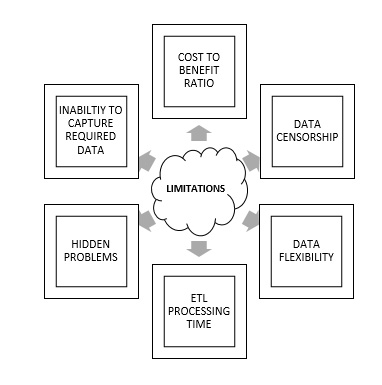9 Disadvantages and Limitations of Data Warehouse
9 Disadvantages and Limitations of Data Warehouse: Data warehouses aren’t regular databases as they are involved in the consolidation of data of several business systems which can be located at any physical location into one data mart. With OLAP data analysis tools, you can analyze data and use it for taking strategic decisions and for prediction of trends.
Even with the innumerable benefits, implementing a data warehouse model for your business might have some drawbacks.
For example, if a particular organization has several departments which have their own sub-sections, the IT department will have the workload of several such divisions. Each division would have to present data to the IT department which is tedious considering few divisions would have to collect the information from their customers which wasn’t recorded before. This would make the entire process of data generation cumbersome for a large organization.

9 Disadvantages and Limitations of a Data Warehouse
In this article, we will discuss various disadvantages of Data warehouse.
Maintenance costs outweigh the benefits
Data warehouses for a huge IT project would involve high maintenance systems which may affect the revenue for medium scale organizations. The cost to benefit ratio is on the lower side as it not only involves systems with equipped technology but also longer hours as an investment from the IT department.
This would restrict the organization’s growth especially when it’s a business which is adapting to its market conditions.
Data Ownership
An important concern of Data warehouses is the security of data. Primarily, Data warehouses are marked for software applications for service. This restricts your data security as the data which has been implemented locally might be sensitive only for a certain department.
Leaking of data within the same organization could lead to hiatus and cause problems for the executives. You can avoid this by ensuring that the individuals entrusted with the analysis are trusted employees of the company with no departmental lineage as it could lead to reluctance because of data censorship.
Also See: Data Warehouse Architecture
Data Rigidity
The type of data imported into a data warehouse is often static data sets which have the least flexibility to generate specific solutions. For the data to be used, it has to be transformed and cleansed which could take several days or weeks.
Moreover, warehouses are subjected to ad hoc queries which are extremely difficult as they have least processing speed and query speed. Even though the queries are restricted to the data marts used during consolidation and integration, most of them are ad hoc queries.
Underestimation of ETL processing time
Often organizations do not estimate the time required for the ETL process and find their work interrupted leading to backlogs. A significant portion of the time required for the entire process of data warehouse development is for extraction, cleaning, and loading of consolidated data into the warehouse. Even with tools to make the process faster, efficient transformation takes up to several days or weeks.
Hidden problems of the Source
Hidden problems of the source arise when an organization finds themselves with problems related to the original source systems which were involved in the importing of data into the warehouse after several years of operation.
Practically, a human error while entering data like property details, like for example, leaving certain fields incomplete or improperly filled could be considered as void property data.
Also See: Data Warehouse Applications
Inability to capture required data
There is always the probability that the data which was required for analysis by the organization was not integrated into the warehouse leading to loss of information. Consider the example of property registration, apart from the regular details, the date of registration plays an important role in statistical analysis at the end of the month. However, such data could be overlooked and not imported.
Increased demands of the users
After success with the initial few queries, users of the facility may ask more complicated queries which would increase the workload on the system and server. With awareness of the features of the data warehouse, there might also be an increase in the number of queries posed by the staff which also increase the server load.
However, if your organization’s systems and servers are equipped with high-end hardware, this wouldn’t be a problem.
Long-duration project
A comprehensive warehouse project might take up to three years to complete. Not all organizations are able to dedicate themselves entirely and are hence more reluctant in investing in a data warehouse. If the organization has to offer very low historical data, a majority of the data mart features will not be utilized as much and will only be a limitation.
Complications
The integration feature is one of the most important aspects of a data warehouse. Which is why it is recommended that an organization pays special attention to the disparate and equally compelling data warehousing tools and their results to arrive at a proper business conclusion and make their decision. This could be a challenging task if the organization’s management is not dedicated and lack experience.
So it was all about Disadvantages and Limitations of a Data Warehouse. If you have any problems then please comment below.

Really good content. Helpful too.
Work a bit but please use simple words.